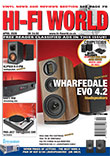Page 3 of 4
Another almost-peculiar property made itself very clear with Safri Duo’s 'Samb Allegro' – tremendously fast but punchy bass. It seemed perfectly timed and I heard texture where I had not before, here in the synth kick-drum beat that underpins the track so dramatically. Modern hi-res recordings such as Marta Gomez singing 'Maria' (24/96) bettered CD in obvious fashion by fleshing out a performance with more intense inner detail – making CD sound a tad barren by way of contrast. With this superb recording, images were hewn from stone with clear space between them – and a vivid dynamic all but defining what high-fidelity must be. Fleetwood Mac’s 'Dreams' (24/96) – a hi-res transcription from an old analogue master tape (1977) – hit me with a dramatic start from Mick Fleetwood’s drum kit that had surgical punch – but some of the cymbal crashes were too well revealed. I know the top end of this track is a bit raspy and here Hugo TT2 made the fact obvious. In effect it revealed limitations in the transcription or original recording. Comparisons got interesting with Diana Krall singing 'Narrow Daylight' on hi-res PCM (24/96) and DSD64. To my surprise there was not much difference. Both were relentlessly sharp in timing, clean and clear, DSD without the romance I associate with it. With classical DSD tracks like Dejan Lazic playing Brahms' 'Piano Concerto No3' although there was fabulous insight - the almost relentless clarity of this DAC made for a lack of organic warmth that was not what I expect from DSD. Again though, the tremendous sense of timing and broad sound stage gave Hugo TT2 a sense of rigid composure no other DAC can match, strings coming through with assured presence. After writing the above I was told Hugo TT2 converts DSD to PCM, presumably because the custom FPGA chip lacks a DSD process route with low pass filter. This explains what I heard though. With hi-res classical such as the Minnesota Orchestra playing Korsakov’s 'Dance of the Tumblers' from 'The Snow Maiden' (24/96), TT2's large canvas made the orchestra sound both vast and dynamically engaging, kettle drums having sudden and solid power when struck, the instruments all seemingly well separated with clear air between them. Again, it was time to run up the volume! This was something I kept doing and suddenly the penny dropped. Using Amp mode at high gain – light blue and above on the volume sphere – maximises dynamic range. And I was running at light blue and above, effectively achieving a dynamic range of 130dB or more. That’s way above the 120dB of top class rivals. An issue Hugo TT2 raised was that of ‘insight’. It appears to have insight into digital, as it were. Transcriptions of old analogue performances had their faults revealed and did not sound wholly better. Modern hi-res recordings fairly assaulted me with everything from detail to dynamics, sounding almost too good to be true. Good CD was fine but old CD was revealed as, well – old CD and not so nice. Bluetooth worked well once I had entered the PIN number demanded, which the handbook fails to mention: it is 0000. Interesting that the limitations of aptX compression became quite obvious in contrast to all else.
Our DIY loudspeaker adaptor leads, XLR to 4mm line socket (not available commercially; go to RS Components).
And finally Hugo TT2 did indeed drive our Martin Logan ESL-X loudspeakers quite loud (Hi gain) via the XLR output sockets, using a pair of adaptor leads I soldered up (XLR to 4mm line socket). At times I fancied there was a tad more detail but then there was less low-end drive, David Bowie's 'Suffragette City' missing a bit of propulsive power. So a bit of a compromise here but do-able all the same. Headphones are best used at Lo gain that limits output to 3V – more than enough. Sound quality showed all the traits I heard with loudspeakers, cross-feed (XFeed) making the experience less in-head.
CONCLUSION Hugo TT2 resolves both CD and hi-res digital with breathtaking clarity, giving a starkly clear and concise sound unmatched elsewhere. It also has fantastic timing and almost peculiarly tight yet punchy bass. It is a little short on warmth, especially with DSD, majoring on deep analysis instead – undoubtedly its forte. To hear CD and hi-res like you’ve never heard it before, and as you will not hear it anywhere else, this is the DAC to audition.
CHORD ELECTRONICS HUGO TT2
OUTSTANDING - amongst the best. Fabulous DAC with analytical and precise sound. Unimpressive with DSD.
FOR - great sound from CD - styling and build quality - small size - wide range of inputs
AGAINST - lacks warmth - dry DSD
Chord Electronics +44 (0)1622 721444
|
Search
Hi-Fi World, Powered by Joomla!; Hosted by Joomla Wired.






